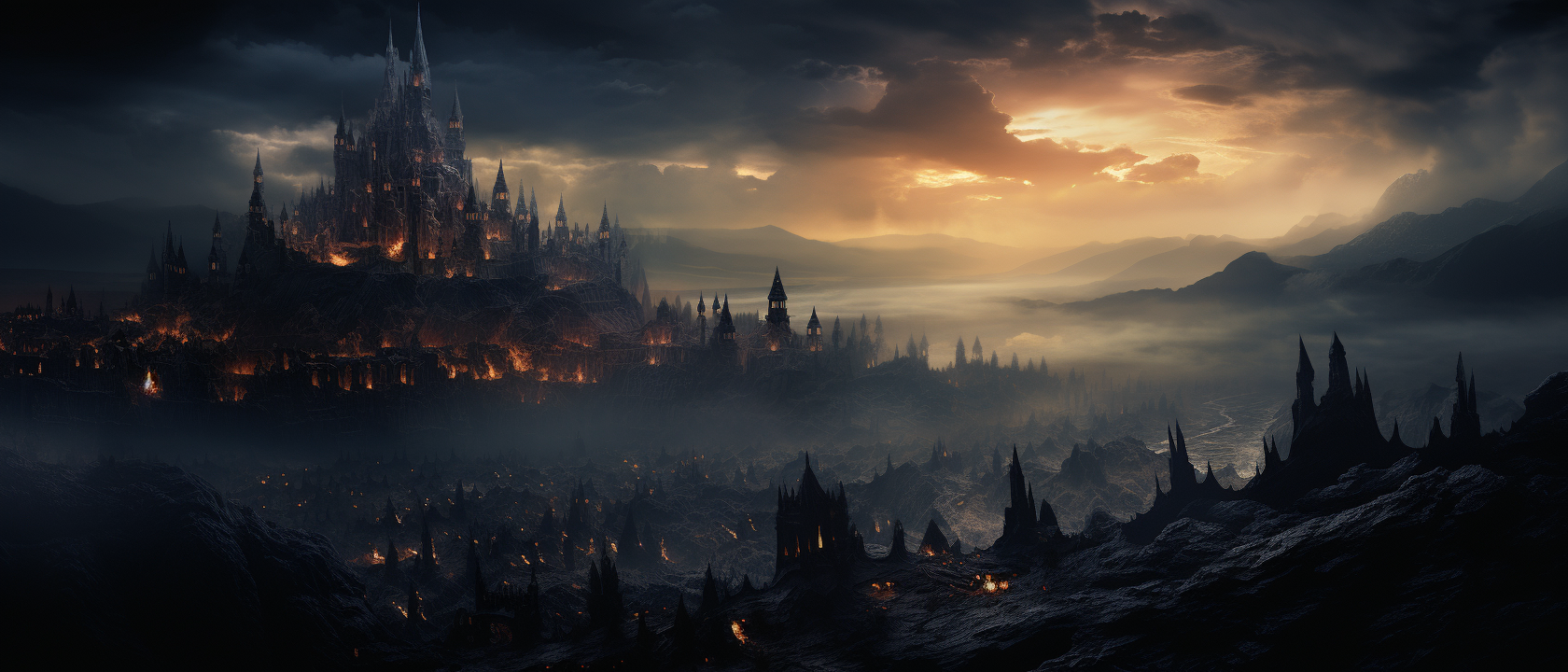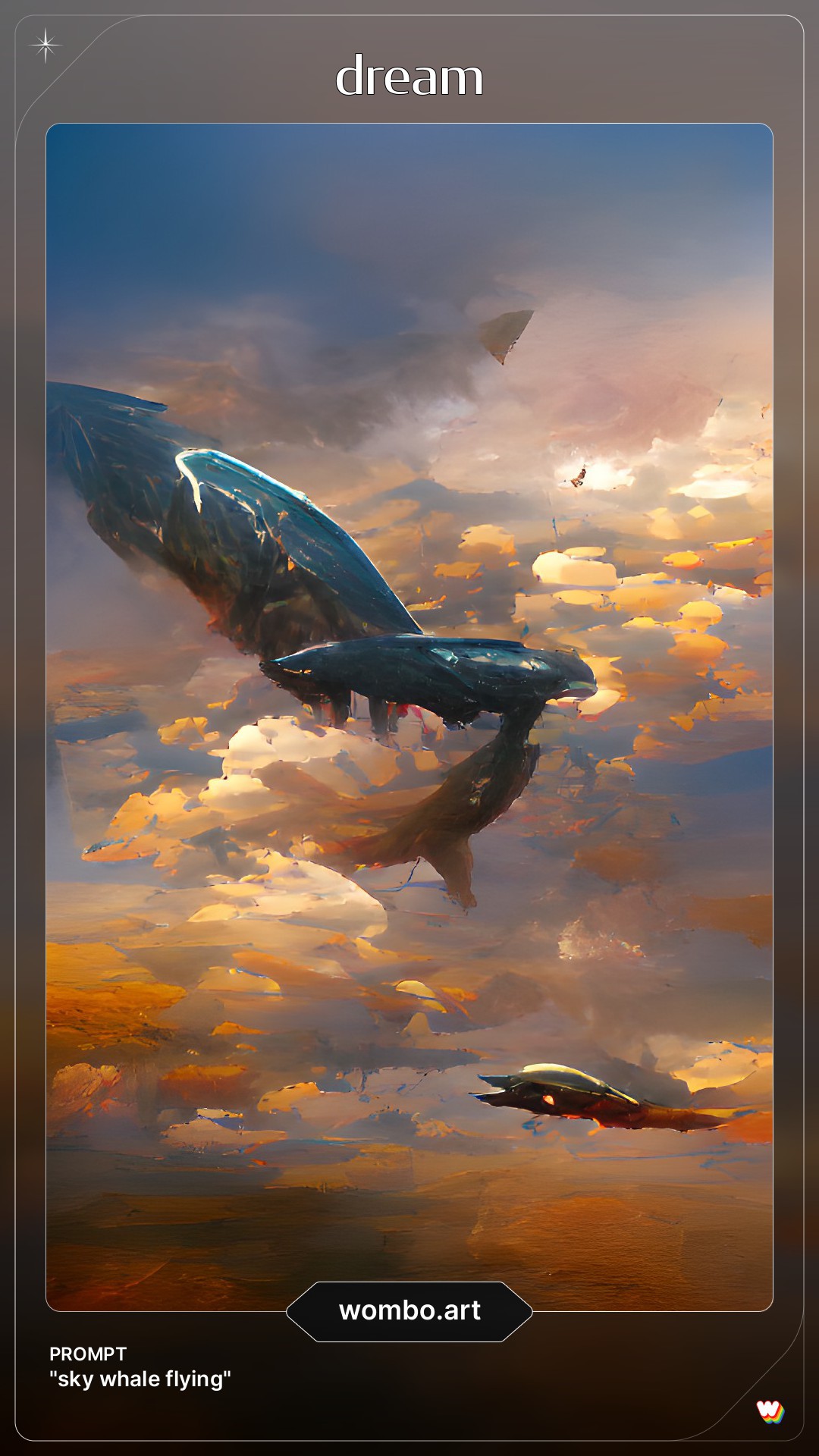
The Sky Whales are one of Koria's rarest species. There are only a few dozen of Sky Whales alive and it is a rare and beautiful sight when you are lucky enough to see one.
The Sky Whales are flying - mostly gliding - through the sky and the clouds which is their natural habitat. They eat something similar to Krill by opening their giant mouths and let the Krill fly in. This Krill is living inside clouds and the remnants of past thunderstorms so the Sky Whales are said to be following thunderstorms or huge cloud formations. What most people aren't aware of is that Sky Whales are mostly invulnerable against the winds and the lightning. Their thick skin absorbs most of the lightnings energy and some whales store it for defense against their only natural enemy.
Sky Whales have six wings and six eyes and a tail with four parts so they can maneuver between the currents of the air and the difference of cold and warm air. Their six eyes are equally distributed in a circle around their head so they can see what is below, above or besides them. Some may think to follow the clouds and thunderstorms, but mostly because of their only natural enemy, the flying Velcoraptor.
Sky Whales are flying Whales with a thick skin to protect them against rain, heat, storms, Velcoraptors, and lightning. After they reached adulthood they develop a crystal-like organ in their mouth where they can store a decent amount of lightning - absorbed through their skin - to use the energy to defend themselves.
If a Sky Whales dies, humans and other species are going to harvest its entrails, meat and skin. The skin is a good resource for clothing, sails and packaging.
Every Sky Whale has four gas bladders to hold them afloat: one near the head, one near the tail and one on each side of their body. They can fill them with gas and release it if needed. With those bladders they do not only stay afloat but they can descent and ascent.
With their bilateral organ they can sense the hot and cold flow of the air currents so they can sense when they can ascend and descent without the help of their gas bladders.
The Whale uses his six wings and four fins on its tail to navigate through the sky, high above the ground. They navigate with their eyes, using the points of interest on the ground. Some might think that the Sky Whale remembers to most likely places for thunderstorms, but one can not be sure.
The average lifetime of a Sky Whale is approximately around 200 years, but this isn't accurate since not even the elves knows how long the life of a Sky Whale really is. Sightings of specific Whales calculated the number of years, but there are no reliable data, not even the age of dead Sky Whales.
When a Sky Whale is born alive - flying high above the ground - the father will carry it while the mother cleans it. After a few days they teach their newborn to get afloat and will protect it the first two to three years from any harm and teach it the ways of the Sky Whale.
The moment the young Sky Whale develops the ability to absorb lightning - and is developing the crystal-organ in its mouth - the parents teach them how to use the energy. At this moment the young Sky Whale knows how to defend itself against the deadly Velcoraptor using its wings, tails and the lightning using crystal-organ. After a few years it will separate itself from its parents and start its own small flock until mating and dying.
A Sky Whale only mates once, max. twice in its life. The female tries to fly very slowly in a line as straight as possible. The male flies the same way but on its back, extend its penis and tries to mate with the female. Sometimes they need more than two attempts to do it. Once the male entered the female, it will release its semen and tries to fly normal again.
The female can get pregnant every two to four years. The pregnancy lasts a year and then the female gives birth to one, in very rare cases two, young Sky Whales.
The Sky Whales only have two natural enemies: the nature, the force of thunderstorms and the Velcoraptors. Those flying scavengers with sharp teeth and claws attack in herds of ten or more and dig through the eyes or the skin of a Sky Whale, destroying organs or the gas bladders, crashing the Whale onto the ground, where it dies in the end and being food for the Velcoraptors and harvestable materials for the species living on the ground.
When a Sky Whale dies it falls to the ground. The Whale knows that it is about to die but can not do anything about it. It can not land on the ground or in the sea so it stays afloat as long as it can.
When its heart stops or if its energy is depleted, it will descent and crash onto the ground. Sometimes the belly of the Whale splits open, killing it in the process, scattering flesh, blood and entrails all around the area. In rare cases a Sky Whale drops onto a settlement, burying it underneath it.
The consequences from this are possible diseases from the rotting meat, infertile soil from the blood poisoning, chaos and destruction from the impact of the body, gas poisoning or explosions from the gas bladders.
If harvestable, humans and other species gather around the corpse and harvest what they could use. Meat, if not rotting. Skin for sails, clothes and packaging. Organs for travel resources like drinking hoses, bones for powders or building houses or tents for traveling.
It is advised to not get into the closer proximity of a Sky Whales corpse because of the blood or the gas. As long as Velcoraptors are circling above the corpse one should avoid the corpse at all costs.
All text, ideas, plots and articles in this world are created by CrazyEddie & Morbvs. All media (pictures, videos, music and all variants of it) belongs to their respective owners unless stated otherwise. (Version of 1st January
2024
)
Cover image:
Koria Main Header
by
CrazyEddie via Midjourney
Comments
Please Login in order to comment!






Is there a white sky whale called Moby Dick?
Sadly not officially, but I can create a story for it. :)
Needs an Ahab figure to hunt it, lol